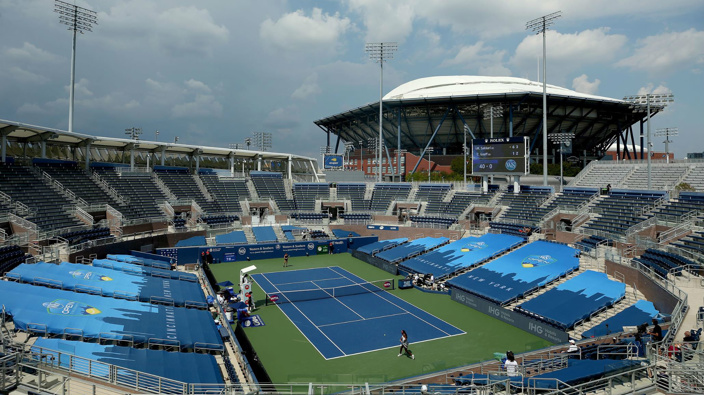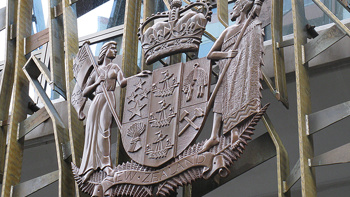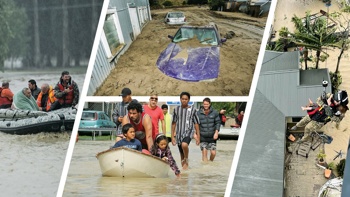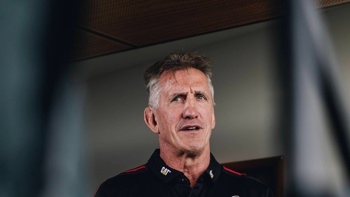Follow
the podcast on

When Wimbledon was cancelled amid the ongoing coronavirus pandemic, it became the first of tennis' grand slams to be scrapped since World War II in 1945.
There was uncertainty, too, surrounding the next major, the US Open, but the event is going ahead in New York with no fans, no mixed doubles and limited fields in men's and women's doubles. This despite tournament revenue -- which hit $399.6 million in 2019 -- expected to drop by as much as 80%.
Tennis' bubble
Be it in the NBA, NHL or Champions League, bubbles are the new norm in sports, accompanied by coronavirus tests and temperature checks.
The US Open is also operating a bubble, with players and their limited entourages being shuttled to and from the tournament's hotels to the tennis site in Flushing Meadows, Queens. Instead of the usual accommodation in swanky, high-rent Manhattan, all but a few are staying in Long Island at the Long Island Marriott and Garden City hotel.
Players got used to the new setup this week -- since a warm-up tournament normally held in Cincinnati, Ohio, is being staged at the US Open site -- and so far there have been virtually no complaints.
"It's nice," 2012 US Open champion Andy Murray told reporters. "They've done a really good job at the hotel. They've got games and arcades and things like that, which I enjoy.
"They're putting on different food in the evenings for the players. We can get delivery. Room is absolutely fine. You have a gym there. So, yeah, it's absolutely fine."
Private housing was an option given to players but Murray declined because he said costs were "astronomical."
But Serena Williams -- making a ninth attempt at landing a record 24th grand slam title -- and Novak Djokovic preferred their own digs.
For Williams, past health scares including pulmonary embolisms swayed her decision.
"I didn't want to be in the hotel because I have lung issues, so I felt like it was actually a big risk for me personally," the American told reporters. "At my house, I can control more. There is no housekeeping, there is none of that type of stuff.
"And so as much as I want to be here, it's great, but I have genuine health issues that I just really needed to put my mind at rest to even be able to perform in New York."
Djokovic, who tested positive for the coronavirus after his ill fated Adria Tour was cut short, is based at a home described by the New York Times as "nestled amid trees."
"With the trees and serenity, being in this kind of environment is a blessing," Djokovic told the newspaper. "And I'm grateful, because I've seen the hotel where the majority of players are staying.
"I don't want to sound arrogant or anything like that, and I know the (United States Tennis Association) did their best in order to provide accommodation and organize everything and organize these bubbles so the players can actually compete and come here, but it's tough for most of the players, not being able to open their window and being in a hotel in a small room."
Notable no-shows
Players have said they felt safe in the new environment. But due to the pandemic, several stars bypassed the US Open.
The highest-profile absentee is defending men's champion Rafael Nadal, who could have tied Roger Federer for the all-time men's grand slam lead.
Practicing on clay rather than hard courts -- the surface of the US Open -- the Spaniard was always leaning against making the trip and officially withdrew in early August.
"The situation is very complicated worldwide, the COVID-19 cases are increasing, it looks like we still don't have control of it," the 19-time grand slam winner said.
Other notable no-shows include Stan Wawrinka, Simona Halep, Ashleigh Barty, Kiki Bertens, Elina Svitolina, Belinda Bencic, 2004 winner Svetlana Kuznetsova, Gael Monfils, Nick Kyrgios and defending women's champion Bianca Andreescu.
Andreescu, however, hasn't played since last year due to injury.
Federer and 2009 titlist Juan Martin del Potro had already been ruled out as they recover from knee injuries.
So should there be an asterisk next to this year's event?
"It still has to be tennis that's played, asterisks or not," Williams said. "I think this whole year deserves an asterisk, because it's such a special year, history we have never been through in this world, to be honest, not this generation, not this lifetime.
"And if you win, it was, like, 'Wow, I was able to win in this crazy circumstance where there was no fans.'"
Those taking to the court will be allowed to wear clothing with social justice logos or slogans, subject to size restrictions and pre-approval.
Williams endured a rocky buildup to the US Open, suffering upset losses in her two warmups, and has a potentially very difficult draw.
Djokovic would have been the men's favorite, even if Nadal and Federer were in the draw. He is bidding for an 18th major, which would bring him to within one of Nadal and two of Federer.
No raucous crowds
The most raucous fans at grand slams likely appear at the US Open -- particularly for night matches at Arthur Ashe stadium, the largest regularly used tennis facility in the world with a capacity of roughly 24,000.
This year without the spectators, players will have to summon their own energy in potentially marathon encounters. No help from teammates is available.
"Tennis is such a mental sport, and I guess it makes it way more difficult without fans, because I just imagine playing in the fifth set on Arthur Ashe, night session, way past midnight, and in a normal year you get so much energy from the fans," said 2020 Australian Open finalist Dominic Thiem, who lost to Nadal in one such encounter in the 2018 quarterfinals.
"They give you so much, all this atmosphere.
"And now, in an empty stadium, maybe your coach and your team is there, these are the only people, that makes it, I guess, very, very lonely, very, very tough, and that's going to be a very interesting thing to experience."
Thiem, though, and the other 31 seeds have been given the suites on Arthur Ashe stadium that cost on average around $500,000 over the fortnight.
"I have quite a big suite," said tennis' newest grand slam winner, Sofia Kenin. "It's really comfortable there. I have a couch, TV, go outside on the balcony, watch practices on Ashe.
"It's a bit special. It makes us feel a lot better. I'm really grateful for that."
More electronic line calling
To limit the numbers on site and in the bubble, only the two largest courts, Arthur Ashe and Louis Armstrong, are using the regular allotment of chair umpires and lines people.
The rest of the courts will consist of chair umpires but no lines people. Instead, "out" calls will be made by Hawk-Eye, which can also identify foot faults.
text by Ravi Ubha, for CNN
Take your Radio, Podcasts and Music with you









